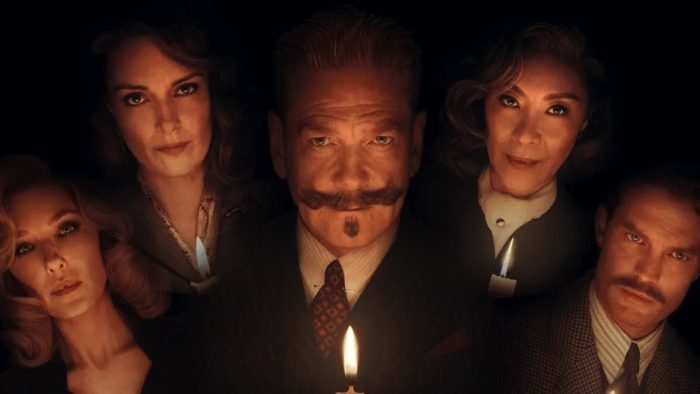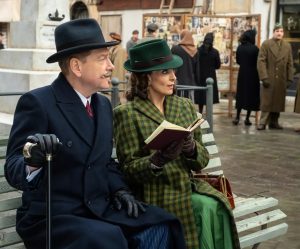Movie Review: Agatha Christie’s Hercule Poirot is on the case in ‘A Haunting in Venice’

Reviewed by Jeffrey Sanzel
With over two billion books in print, Agatha Christie remains history’s second best-selling author (just behind Shakespeare). Her works span sixty-six detective novels and fourteen short story collections. Having opened in 1952, The Mousetrap is the world’s longest-running play, with over twenty-nine thousand performances. Christie’s best-known creations are the private detective Hercule Poirot and the amateur sleuth Miss Marple.
Poirot—the meticulous Belgian of the “little gray cells”— is featured in thirty-three novels and fifty-one short stories, with over a dozen films following his exploits.
Notable actors such as Albert Finney (nominated for an Academy Award for Murder on the Orient Express), Peter Ustinov, Alfred Molina, John Malkovich, and Tony Randall donned the waxed mustache. David Suchet has been the most successful and beloved with Agatha Christie’s Poirot series, which presented seventy episodes from 1989 to 2013. Suchet’s large-than-life Poirot remarkably manages to remain wholly dimensional.

In 2017, Kenneth Branagh directed and starred in Murder on the Orient Express, a labored adaptation that paled in comparison to the 1974 film and the 2010 television version. Branagh followed it up with the even less adept Death on the Nile (2022).
His newest entry, A Haunting in Venice, claims its source as Hallowe’en Party (1969). The crisp novel deals with a girl who claims to have witnessed a murder and, shortly after, is drowned in a bobbing-for-apples tub. The similarities between the source and the film are slim. Apart from one character, a few names, a tub of apples, and a Halloween setting, A Haunting in Venice is an unrelated tale.
Hercule Poirot (Branagh) lives in an unsettled Venetian retirement with a bodyguard, ex-policeman Vitale Portfoglio (Riccardo Scamarcio). Mystery writer Ariadne Oliver (Tina Fey), Poirot’s acquaintance with whom he shares a professional history and a slightly antagonistic bent, coerces Poirot into attending a séance at a nearby palazzo, which follows a children’s Halloween party. Skeptic Poirot agrees to accompany her, intending to reveal the medium as a fraud.
The palazzo’s owner, Rowena Drake (Kelly Reilly), wants to contact her daughter, Alicia (Rowan Robinson), who had committed suicide by throwing herself into the canal a year earlier. The guests include the family doctor, Leslie Ferrier (Jamie Dornan), his son, Leopold (Jude Hill), and the housemaid, Olga Seminoff (Camille Cottin). The medium, Joyce Reynolds (Michelle Yeoh), speaks in the daughter’s voice, proclaiming she was murdered. Poirot quickly exposes Reynolds as a fake. But is she? While Poirot reveals her confederates—Romani siblings Desdemona and Nicholas Holland (Emma Laird and Ali Khan)—doubt looms.
The ensuing plot hinges on the revelation of Alicia’s killer and the question of the palazzo’s haunting by the ghosts of children locked in to die during the plague years.
A Haunting in Venice is an old dark house thriller with the requisite rainstorm, a falling chandelier, strange shadows, whispering voices, and assorted things that go bump in the night. The real stars are the technical elements. Visually, the film is exquisite: Haris Zambarloukos’s whirring and winding cinematography complements John Kelly’s elegant and evocative production design.
The performances are solid enough, all playing in the same world—but certainly not Christie’s universe. In a complete departure from the author’s self-satirizing writer (cleverly played by Zoë Wanamaker in the series), Fey’s Oliver is a wise-cracking 1940s soubrette and Poirot’s active adversary. Yeoh brings a winking gravitas to the medium, and Reilly ably manages a mother’s grief. Laird and Kahn make for a mercurial pair.
The center of any Poirot mystery is, of course, Poirot. Branagh’s twenty-first-century reinterpretation of the role results in a unique, often troubled, human character. Oddly, the choice becomes problematic, offering a Poirot with a lack of “Poirot-ness.” Missing is the twinkling genius, one step ahead. Instead, this Poirot runs alongside the pack until the final moments. However, Branagh embraces Christie’s vision in the resolution, where he exercises his insights and logic in unraveling the solution. Here, Branagh finds a few moments to shine, offering a glimpse of his potential.
A Haunting in Venice is a distinct improvement over Murder on the Orient Express and Death on the Nile. But whether Haunting is a Christie-inspired film or just a movie cashing in on the author’s fame, the answer must veer towards the latter. Viewers seeking a traditional Poirot murder mystery with the classic intrepid detective will most likely be frustrated and disappointed. Those more flexible (or less invested in the canon) will find a quick-paced and visually satisfying thriller.
Rated PG-13, the film is now playing in local theaters.






